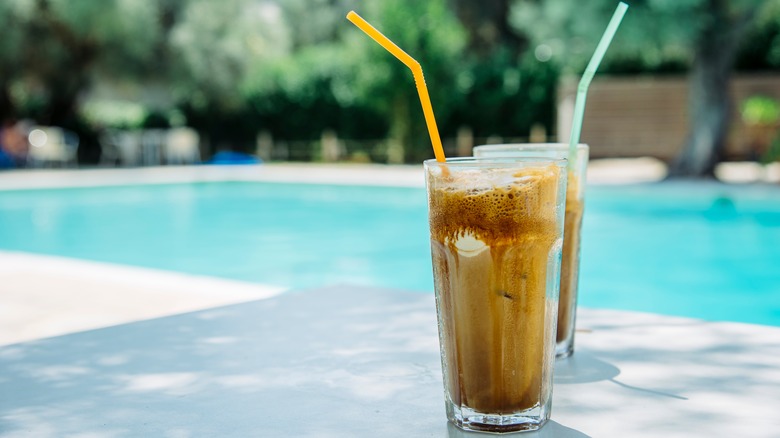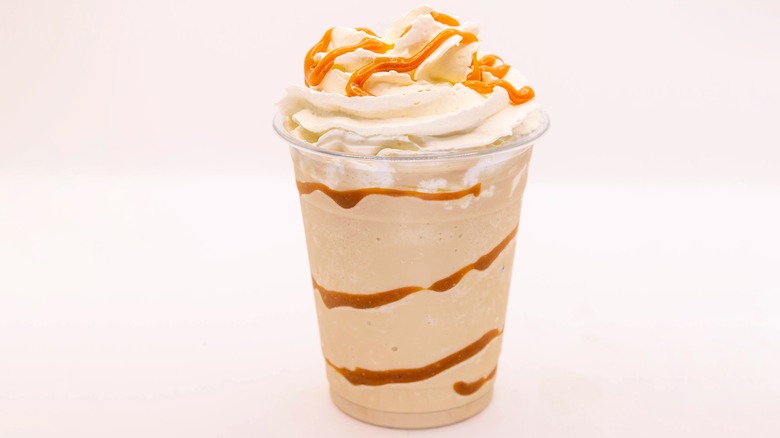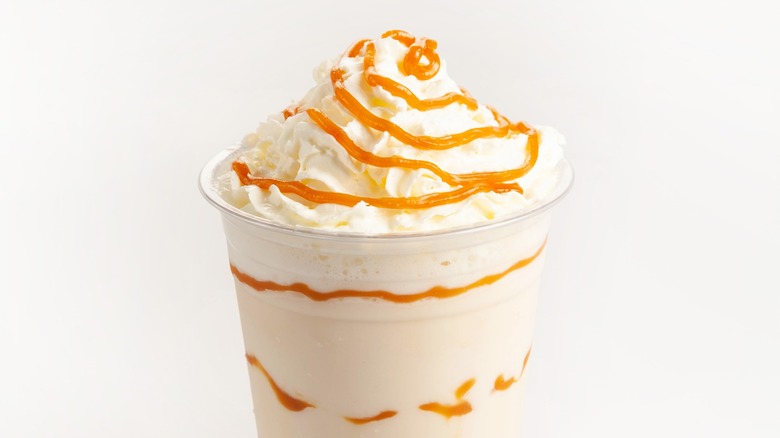What Exactly Is A Frappe (And Is It Different Than A Milkshake)?
If you're a coffee lover, then it's likely you're familiar with a frappe. If you prefer ice cream, then a classic milkshake may be your go-to. While you likely know what goes into a milkshake, you may be less likely to know what exactly makes up a frappe. In addition, both drinks don't have just one definition. Especially when it comes to a frappe, you'll find that what goes into the drink entirely depends upon your location.
Merriam-Webster defines a milkshake as "a thoroughly shaken or blended drink made of milk, a flavoring syrup, and often ice cream." One notable difference is in New England, where a milkshake doesn't include ice cream and instead only contains milk and syrup. In this part of the country, the ice cream makes the drink a frappe, along with the fact that the drink is created by shaking and blending it until it becomes frothy on the top. In some parts of Rhode Island and Massachusetts, a cabinet is essentially a New England frappe: coffee syrup, ice cream, and milk.
Typically, a frappe is a drink that is shaken, blended, or beaten and made with espresso or coffee, sugar, milk or water, and ice. Some variations include tea, juice, or hot chocolate, but the beverage is typically associated with coffee. Internationally, a frappe often has different meanings. For instance, in Bulgaria, they often replace milk or water with soda, while Serbia includes ice cream and whipped cream on top.
What is the history of the frappe?
The frappe began appearing as early as the mid-nineteenth century and often resembled an iced coffee. But Nestlé typically claims the frappe you know today as its invention. The beverage gained notoriety in 1957 at Greece's Thessaloniki International Fair. Giannis Dritsas, who was representing Nestlé, was showing off an instant chocolate beverage for kids that contained milk, chocolate at the bottom, and was made in a shaker. Dimitris Vakondios, another coworker who was trying to make coffee during their break, couldn't find any hot water, so he blended instant coffee granules with cold water and ice cubes, placed it in the shaker, and created a frappe.
This variation of the frappe, or instant coffee, sugar, ice cubes, and water, is still a go-to order in Greece and Cyprus. Sometimes, people add milk to the beverage, though this version is more common in Cyprus. In the late 1970s, the frappe became Greece's national coffee drink.
Although "frappe" translates to "shaken" or "stirred" in French, a French frappe is generally made in a shaker and simply contains milk and fruit juice. The Greek version also includes different levels of sweetness. You can order the drink glykós (sweet and with the largest amount of sugar), métrios (medium), or skétos (plain and without sugar). The drink is now popular in other countries including Australia, Belgium, Bulgaria, France, Germany, the Netherlands, Switzerland, the U.K., and the U.S.
Is a frappe the same thing as a Frappuccino?
If you're a Starbucks regular, then a Frappuccino probably doesn't sound foreign to you. However, a frappe is not a Frappuccino. A Frappuccino is an iced cappuccino that was introduced by George Howell's coffee shop in Massachusetts, The Coffee Connection. The drink was created in the summer of 1992 by Howell and Andrew Frank, a former employee.
"People were lining up out the door for it," Howell, the former owner, told TODAY Food. "I was very aware of Starbucks' rise from 1987 forward," Howell said. In 1989, Howell visited Seattle. TODAY reports that after visiting Torrefazione Italia café (a spot Starbucks bought in 2003), Howell got some ideas.
"There it was. A frozen cappuccino was being made in a granita machine. The second I tasted it — it was just a fantastic, simple drink. I knew it was going to be big," he said. His guide told him that the ingredients included "very strong coffee, sugar and milk." At his shop, Howell and Frank developed their own variation using a frozen yogurt machine.
Howell said, "The key to the Frappuccino that we created was getting it balanced ... It [needs to be] very smooth, sort of like a soft ice cream, but different. [Frank] came up with 'Frappuccino.'" By 1993, the drink had appeared in Howell's Connecticut, New York, New Jersey, and Massachusetts stores. Starbucks experimented with its own Frappuccino using a blender, then "bought out" The Coffee Connection and the name "Frappuccino."


